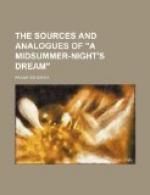* * * * *
Sec. 3. THE FAIRY PLOT
Siecles charmants de feerie,
Vous avez pour moi mille attraits,
Que de fois dans le reverie,
Mon coeur vous donne de regrets.
Tout ne fut alors que mensonge aimable;
Tout n’est plus que
realite;
Rien n’est si jolie que la fable,
Si triste que la verite!
* * * *
III
In The Midsummer-Night’s Dream, Shakespeare presents a conception of fairy-land as original as that which owes its propagation to Perrault and the other French collectors of fairy-tales; its merits as a popular delineation of the fairy-world are proved by the fact that it has obtained the sanction and approval of tradition, passing almost at once into an accepted literary convention; so that even to-day it is not easy to shake off the inherited impression that the fairies are only what Shakespeare shows them to be. He did not, of course, invent them; he had doubtless both read of them and heard tales of them; but he invested them with a delicate and graceful fancy that has held the popular imagination ever since. Thanks to him, the modern English conception of the fairies is different from the conceptions prevalent in other countries, and infinitely more picturesque and pleasant.
As before, it will be convenient to deal first with the names of his characters.
Oberon is the English transliteration of the French Auberon in the romance of Huon of Bordeaux, and Auberon is probably merely the French counterpart of Alberich or Albrich, a dwarf occurring in the German Nibelungenlied and other works. Etymologically Alberich is composed of alb = elf and rich = king. The name Oberon appears first in English literature in Lord Berners’ translation of Huon of Bordeaux (c. 1534), and afterwards in Spenser[27] and in Robert Greene’s play James IV, which was acted in 1589.[28] But the king of the fairies in Chaucer[29] is Pluto, and the queen Proserpine.
Titania. Proserpine is the wife of Pluto (in Greek, form, Persephone, wife of Dis). In Elizabethan times, Campion’s charming poem “Hark, all you ladies that do sleep"[30] keeps the name of “the fairy-queen Proserpina.” Shakespeare appears to have taken the name Titania from Ovid,[31] who uses it as an epithet of Diana, as being the sister of Sol or Helios, the Sun-god, a Titan. Scot, in his Discovery of Witchcraft,[32] gives Diana as one of the names of the “lady of the fairies”; and James I, in his Demonology (1597) refers to a “fourth kind of sprites, which by the Gentiles was called Diana and her wandering court, and amongst us called the Phairie.”
Curiously enough in Shakespeare’s most famous description of the Fairy Queen, she is called Queen Mab;[33] this is said to be of Celtic derivation. Mercutio’s catalogue of Mab’s attributes and functions corresponds closely with the description of Robin Goodfellow.




